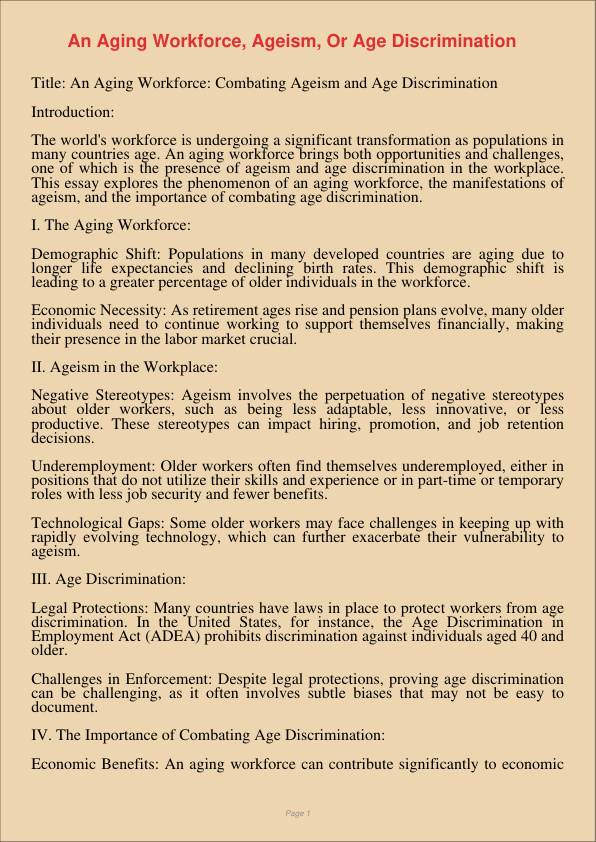Title: An Aging Workforce: Combating Ageism and Age Discrimination
Introduction:
The world’s workforce is undergoing a significant transformation as populations in many countries age. An aging workforce brings both opportunities and challenges, one of which is the presence of ageism and age discrimination in the workplace. This essay explores the phenomenon of an aging workforce, the manifestations of ageism, and the importance of combating age discrimination.
I. The Aging Workforce:
Demographic Shift: Populations in many developed countries are aging due to longer life expectancies and declining birth rates. This demographic shift is leading to a greater percentage of older individuals in the workforce.
Economic Necessity: As retirement ages rise and pension plans evolve, many older individuals need to continue working to support themselves financially, making their presence in the labor market crucial.
II. Ageism in the Workplace:
Negative Stereotypes: Ageism involves the perpetuation of negative stereotypes about older workers, such as being less adaptable, less innovative, or less productive. These stereotypes can impact hiring, promotion, and job retention decisions.
Underemployment: Older workers often find themselves underemployed, either in positions that do not utilize their skills and experience or in part-time or temporary roles with less job security and fewer benefits.
Technological Gaps: Some older workers may face challenges in keeping up with rapidly evolving technology, which can further exacerbate their vulnerability to ageism.
III. Age Discrimination:
Legal Protections: Many countries have laws in place to protect workers from age discrimination. In the United States, for instance, the Age Discrimination in Employment Act (ADEA) prohibits discrimination against individuals aged 40 and older.
Challenges in Enforcement: Despite legal protections, proving age discrimination can be challenging, as it often involves subtle biases that may not be easy to document.
IV. The Importance of Combating Age Discrimination:
Economic Benefits: An aging workforce can contribute significantly to economic growth and stability. Older workers bring valuable skills, experience, and a strong work ethic, which can boost productivity.
Social Responsibility: Combatting ageism and age discrimination is not only a matter of economics but also a social responsibility. Treating older workers with respect and dignity aligns with principles of equality and fairness.
Multigenerational Workforce: Embracing diversity in the workplace, including age diversity, can lead to a more creative and innovative work environment. A multigenerational workforce can offer different perspectives and approaches to problem-solving.
V. Strategies to Combat Age Discrimination:
Education and Training: Implement training programs to raise awareness about ageism and educate employees and employers about its negative consequences.
Diversity and Inclusion Policies: Develop and enforce policies that promote age diversity and inclusivity within the workplace.
Mentorship and Skill Development: Facilitate mentorship programs to bridge the technological skills gap and support older workers in staying competitive.
Conclusion:
An aging workforce presents both opportunities and challenges to economies and societies worldwide. To fully realize the benefits of an older workforce, it is essential to combat ageism and age discrimination. Embracing age diversity, respecting older workers, and implementing legal protections and policies are key steps toward a more inclusive and equitable workplace for all age groups. This is not only an economic necessity but also a matter of social responsibility and ethical imperative in today’s society.

「真诚赞赏,手留余香」
真诚赞赏,手留余香
使用微信扫描二维码完成支付
